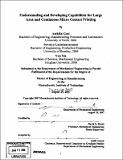Understanding and developing capabilities for large area and continuous micro contact printing
Author(s)
Goel, Ambika; Laxminarayanan, Sowmya; Xia, Yun
DownloadFull printable version (25.59Mb)
Other Contributors
Massachusetts Institute of Technology. Dept. of Mechanical Engineering.
Advisor
David E. Hardt.
Terms of use
Metadata
Show full item recordAbstract
Micro contact printing is a high spatial resolution-patterning tool that can be used for printing on large and non-planar surfaces because of which it has begun to find important applications in printed organic electronics and fiber optics. However, problems like achieving precise alignment and registration, air bubble trapping and low production rate still remain unresolved. The goal of this thesis is to conceptualize and implement a low cost solution to these problems to be used by a nano-technology based company in Cambridge, Massachusetts. In this dissertation, we first present an extensive literature review of soft lithography techniques, focusing more on micro-contact printing and critical factors for taking this technology from laboratory to commercial production. We then introduce another printing technique called flexography and discuss how this method when combined with micro contact printing can help in overcoming the above stated limitations and at the same time achieve high throughput rate at low cost. We propose a Flexography style micro contact printing mechanism with rotating cylindrical stamps enabling reel to reel processing. Finally, results from the experiments conducted to study the effect of parameters like ink concentration, speed and pressure on the print quality are documented.
Description
Thesis (M. Eng.)--Massachusetts Institute of Technology, Dept. of Mechanical Engineering, 2007. Includes bibliographical references (p. 141-143).
Date issued
2007Department
Massachusetts Institute of Technology. Department of Mechanical EngineeringPublisher
Massachusetts Institute of Technology
Keywords
Mechanical Engineering.